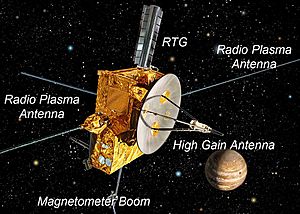Ulysses (spacecraft) facts for kids
Ulysses was a special robot spacecraft, like a space explorer. It was built by two big space groups working together: NASA from the United States and the ESA from Europe. This amazing spacecraft was launched into space on October 6, 1990. Its main job was to study the Sun, especially parts of it that no other spacecraft had looked at closely before. It also gathered important information about the giant planet Jupiter.
Contents
What Was Ulysses?
Ulysses was designed to be a unique space probe. Unlike most spacecraft that orbit planets, Ulysses was sent on a mission to orbit the Sun in a very special way. It was the first spacecraft to fly over the Sun's north and south poles. This allowed scientists to learn new things about our star.
A Team Effort in Space
The Ulysses mission was a great example of international teamwork. NASA and ESA worked together on every part of the project. NASA provided the launch and a special power source for the spacecraft. ESA built the spacecraft itself and many of its scientific tools. This partnership helped make the mission a big success.
Ulysses' Incredible Journey
The journey of Ulysses was long and carefully planned. It needed a lot of speed to reach its unique orbit around the Sun.
Launch into Space
Ulysses began its journey from Kennedy Space Center in Florida, USA. It was carried into space by the Space Shuttle Discovery during mission STS-41. After leaving the shuttle, Ulysses used extra rocket boosters to speed up even more.
Using Jupiter's Gravity
To get enough speed to fly over the Sun's poles, Ulysses needed a special boost. It flew past the giant planet Jupiter in February 1992. Jupiter's huge gravity acted like a slingshot, bending Ulysses' path and giving it the extra speed it needed. This "gravity assist" sent Ulysses out of the flat plane where most planets orbit and put it on a path that would take it over the Sun's poles.
Orbiting the Sun's Poles
After its boost from Jupiter, Ulysses began its long, looping orbits around the Sun. It completed three full orbits, each taking about 6.4 years. During these orbits, it passed over the Sun's north and south poles multiple times. This gave scientists a chance to study the Sun from angles never seen before.
What Ulysses Discovered
Ulysses helped scientists learn many new things about the Sun and the space around it.
Secrets of the Solar Wind
One of Ulysses' main goals was to study the solar wind. This is a constant stream of tiny particles that flows out from the Sun in all directions. Ulysses found that the solar wind coming from the Sun's poles was faster and steadier than the wind coming from the Sun's equator. This was a big discovery that helped us understand how the Sun affects space.
Cosmic Rays and Space Dust
Ulysses also studied cosmic rays, which are tiny, super-fast particles from outside our solar system. It helped scientists understand how the Sun's magnetic field protects us from some of these dangerous rays. The spacecraft also detected tiny bits of space dust, giving us clues about how our solar system formed.
How Ulysses Worked
To do its job so far from Earth and the Sun, Ulysses needed special equipment.
Power in Deep Space
Ulysses used a special power source called a Radioisotope Thermoelectric Generator (RTG). This device turned heat from a radioactive material into electricity. This was important because Ulysses traveled far from the Sun, where solar panels would not get enough sunlight to work.
Scientific Tools on Board
The spacecraft carried many different scientific instruments. These tools were like special sensors and cameras that could measure the solar wind, magnetic fields, cosmic rays, and space dust. Each instrument helped scientists gather different pieces of the puzzle about the Sun and space.
The End of a Great Mission
Ulysses worked for almost 19 years, much longer than planned! It kept sending back valuable information until its power started to run out. The mission officially ended on June 30, 2009. Ulysses taught us so much about the Sun and its influence on our solar system.
Images for kids
-
STS-41 launches from Kennedy Space Center, October 6, 1990.
See also
 In Spanish: Ulysses (sonda espacial) para niños
In Spanish: Ulysses (sonda espacial) para niños








